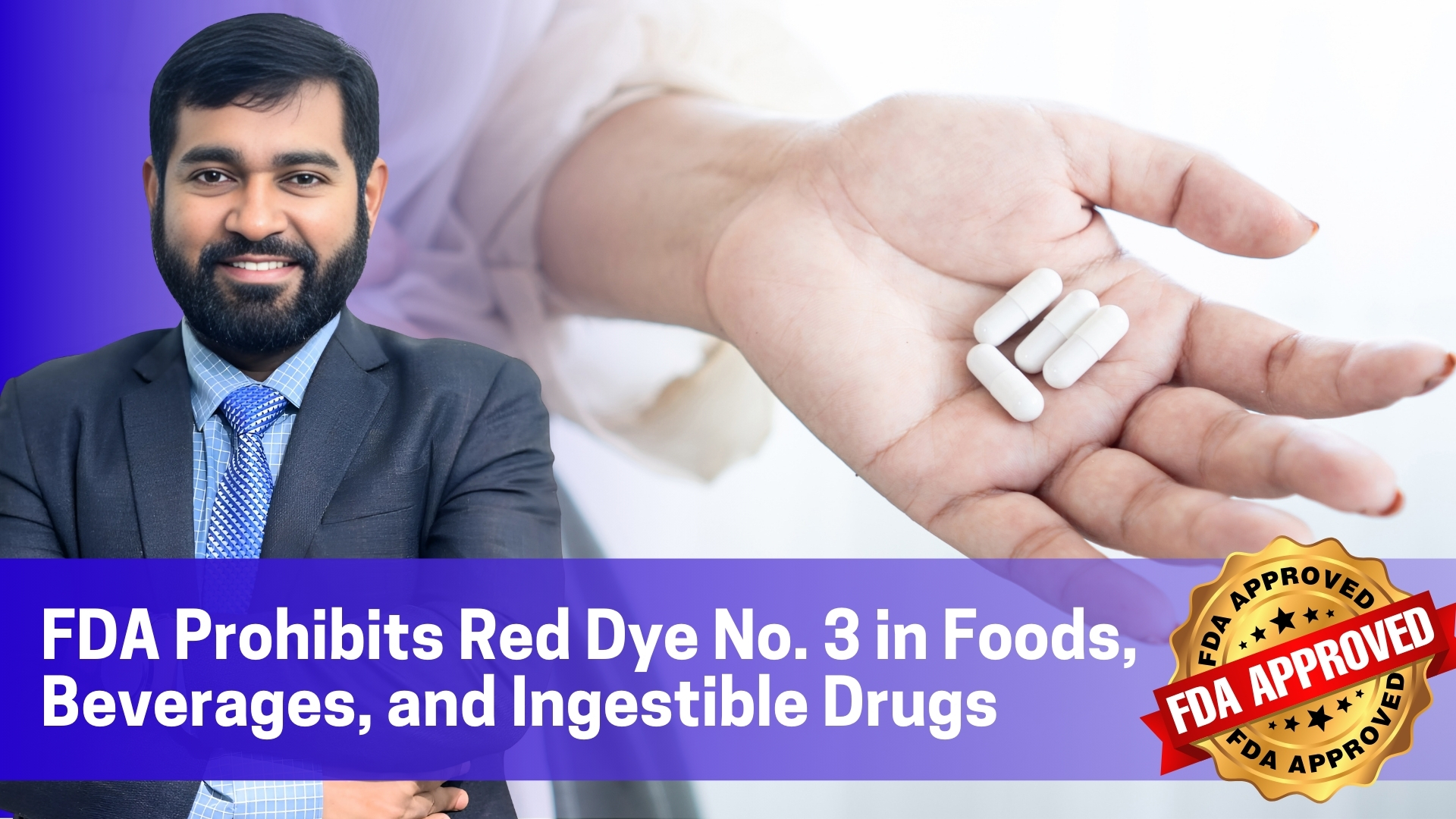27
FDA Prohibits Red Dye No. 3 in Foods, Beverages, and Ingestible Drugs
The U.S. Food and Drug Administration (FDA) has taken a landmark step in food safety by prohibiting the use of Red Dye No. 3 (erythrosine) in foods, beverages, and ingestible drugs. This decision, announced on January 15, 2025, comes after decades of scrutiny and mounting evidence of potential health risks associated with this synthetic food coloring.
The ban reflects the FDA’s commitment to protecting public health and aligns with global efforts to eliminate harmful additives from the food supply. In this detailed exploration, we will delve into the reasons behind the ban, its implications for manufacturers and consumers, and the broader context of food safety regulations.
What is Red Dye No. 3?
Red Dye No. 3, also known as erythrosine, is a synthetic, petroleum-based food coloring that has been widely used in the food and beverage industry since the early 20th century. It is prized for its ability to produce a bright cherry-red color, making it a popular choice for products such as candies, baked goods, frostings, beverages, and even ingestible drugs like cough syrups and gummy vitamins. Despite its vibrant appearance, Red Dye No. 3 has been the subject of controversy due to its potential health risks.
Why Did the FDA Ban Red Dye No. 3?
The FDA’s decision to ban Red Dye No. 3 is rooted in the Delaney Clause of the Federal Food, Drug, and Cosmetic Act. This clause prohibits the use of any food additive or color additive that has been found to induce cancer in humans or animals. Key factors contributing to the ban include:
1. Cancer Risk in Animals
Studies conducted in the 1980s and 1990s revealed that high doses of Red Dye No. 3 caused thyroid tumors in male laboratory rats. While these studies involved doses much higher than typical human consumption, the Delaney Clause mandates a ban if cancer is found in any animal studies, regardless of the dosage.
2. Public Health Advocacy
Health organizations, including the Center for Science in the Public Interest (CSPI), have long petitioned for the ban, arguing that the dye poses unnecessary risks to consumers. The CSPI has described Red Dye No. 3 as a “carcinogen” and called for its removal from the food supply.
3. Global Precedents
Red Dye No. 3 has already been banned in the European Union, Australia, and New Zealand due to similar health concerns. The FDA’s decision brings the U.S. in line with international standards for food safety.
4. Lack of Modern Safety Reassessment
Red Dye No. 3 was approved for use decades ago, and its safety has not been thoroughly reassessed in light of modern scientific standards. The FDA’s decision reflects a precautionary approach to food safety, prioritizing public health over outdated regulatory practices.
Timeline for Implementation
The FDA has provided a transition period for manufacturers to reformulate their products and comply with the new regulations:
-
Food and Beverages: Companies must remove Red Dye No. 3 by January 15, 2027.
-
Ingestible Drugs: The deadline for removing the dye from medications is January 18, 2028.
During this period, products containing Red Dye No. 3 may still be available on the market if they were manufactured before the effective date. However, manufacturers are encouraged to transition to safer alternatives as soon as possible.
What Products Are Affected?
Red Dye No. 3 is found in thousands of food and drug products, including:
-
Candies: Gummy bears, licorice, jawbreakers, and other brightly colored sweets.
-
Beverages: Fruit punches, sodas, and flavored drinks.
-
Baked Goods: Frostings, cookies, and snack cakes.
-
Frozen Treats: Ice creams, popsicles, and frozen desserts.
-
Medications: Gummy vitamins, cough syrups, and other ingestible drugs.
Consumers can identify Red Dye No. 3 on labels under names like "FD&C Red No. 3," "Red 3," or "erythrosine".
Safer Alternatives to Red Dye No. 3
Manufacturers are expected to replace Red Dye No. 3 with natural alternatives or other synthetic dyes that have been deemed safer. Some of the most popular alternatives include:
-
Natural Colorings:
-
Beet juice: A vibrant red pigment derived from beets.
-
Carmine: A red dye made from cochineal insects.
-
Anthocyanins: Pigments extracted from fruits like berries.
-
-
Synthetic Dyes:
-
Red Dye No. 40: A widely used synthetic dye, though it has also been linked to behavioral issues in children.
-
Allura Red AC: Another synthetic dye commonly used as a substitute for Red Dye No. 3.
-
While natural alternatives are generally considered safer, some synthetic dyes may still pose health risks, highlighting the need for continued research and regulation.
Impact on Manufacturers
The ban on Red Dye No. 3 presents both challenges and opportunities for manufacturers:
-
Reformulation Costs: Companies will need to invest in research and development to reformulate their products, which may involve significant costs.
-
Labeling Changes: Products containing Red Dye No. 3 will need to be relabeled to reflect the new formulations.
-
Consumer Preferences: Manufacturers may use this opportunity to market their products as “free from synthetic dyes” or “made with natural colors,” appealing to health-conscious consumers.
Impact on Consumers
The ban is a victory for public health advocates, who argue that removing harmful additives from the food supply is long overdue. While the FDA has stated that there is no direct evidence of cancer risk in humans, the decision reflects a precautionary approach to food safety. Consumers are encouraged to:
-
Read Food Labels: Check ingredient lists for Red Dye No. 3 and other synthetic additives.
-
Choose Whole, Unprocessed Foods: Minimize exposure to synthetic additives by opting for whole, natural foods.
-
Stay Informed: Keep up with updates from the FDA and other health organizations regarding food safety regulations.
Broader Context of Food Safety Regulations
The FDA’s ban on Red Dye No. 3 is part of a broader effort to modernize food safety regulations and protect public health. In recent years, there has been growing concern about the safety of synthetic food additives, including artificial colors, flavors, and preservatives. Key developments include:
-
California’s Ban on Synthetic Food Dyes: In 2023, California passed a law banning Red Dye No. 3 and other synthetic food dyes in school meals, citing concerns about their impact on children’s health.
-
Global Trends: Many countries have already banned or restricted the use of Red Dye No. 3 and other synthetic additives, reflecting a global shift toward safer, more natural food ingredients.
Conclusion
The FDA’s prohibition of Red Dye No. 3 marks a significant step toward ensuring the safety of the U.S. food supply. While the transition period allows manufacturers time to reformulate, consumers can look forward to a future with fewer synthetic additives in their foods and medications. This decision also highlights the importance of ongoing scientific evaluation and public advocacy in shaping food safety policies.
As the food industry adapts to these changes, consumers are encouraged to stay informed and make conscious choices about the products they consume. By prioritizing health and safety, we can collectively work toward a safer, more transparent food system.
Links to FDA Red Dye No. 3 Ban News Coverage
CNN Health Report
Associated Press News
NBC News Health Section
Washington Post Health Coverage
Reuters Health News
CBS News Health Report
Food Safety Government Website
Scientific American Research
New York Times Analysis
Official FDA Announcement
Key Regulatory Details
- Ban effective January 15, 2025
- Transition period until 2027-2028
- Based on cancer and health risk studies




